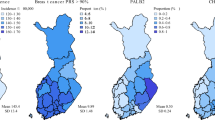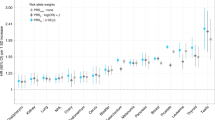Abstract
The knowledge of human genetic variation that will come from the human genome sequence makes feasible a polygenic approach to disease prevention, in which it will be possible to identify individuals as susceptible by their genotype profile and to prevent disease by targeting interventions to those at risk. There is doubt, however, regarding the magnitude of these genetic effects and thus the potential to apply them to either individuals or populations. We have therefore examined the potential for prediction of risk based on common genetic variation using data from a population-based series of individuals with breast cancer. The data are compatible with a log-normal distribution of genetic risk in the population that is sufficiently wide to provide useful discrimination of high- and low-risk groups. Assuming all of the susceptibility genes could be identified, the half of the population at highest risk would account for 88% of all affected individuals. By contrast, if currently identified risk factors for breast cancer were used to stratify the population, the half of the population at highest risk would account for only 62% of all cases. These results suggest that the construction and use of genetic-risk profiles may provide significant improvements in the efficacy of population-based programs of intervention for cancers and other diseases.
This is a preview of subscription content, access via your institution
Access options
Subscribe to this journal
Receive 12 print issues and online access
$209.00 per year
only $17.42 per issue
Buy this article
- Purchase on SpringerLink
- Instant access to full article PDF
Prices may be subject to local taxes which are calculated during checkout



Similar content being viewed by others
References
Bell, J. The new genetics in clinical practice. Br. Med. J. 316, 618–620 (1998).
Beaudet, A.L. 1998 ASHG presidential address. Making genomic medicine a reality. Am. J. Hum. Genet. 64, 1–13 (1999).
Friend, S.H. How DNA microarrays and expression profiling will affect clinical practice. Br. Med. J. 319, 1306–1307 (1999).
Holtzman, N.A. & Marteau, T.M. Will genetics revolutionize medicine? N. Engl. J. Med. 343, 141–144 (2000).
Vineis, P., Schulte, P. & McMichael, A.J. Misconceptions about the use of genetic tests in populations. Lancet 357, 709–712 (2001).
Lichtenstein, P. et al. Environmental and heritable factors in the causation of cancer—analyses of cohorts of twins from Sweden, Denmark, and Finland. N. Engl. J. Med. 343, 78–85 (2000).
Peto, J. & Mack, T.M. High constant incidence in twins and other relatives of women with breast cancer. Nature Genet. 26, 411–414 (2000).
Easton, D.F. How many more breast cancer predisposition genes are there? Breast Cancer Res. 1, 14–17 (1999).
Anglian Breast Cancer Study Group. Prevalence and penetrance of BRCA1 and BRCA2 in a population based series of breast cancer cases. Br. J. Cancer 83, 1301–1308 (2000).
Antoniou, A.C. et al. Evidence for further breast cancer susceptibility genes in addition to BRCA1 and BRCA2 in a population based study. Genet. Epidemiol. 21, 1–18 (2001).
Antoniou, A.C. et al. A comprehensive model for familial breast cancer incorporating BRCA1, BRCA2 and other genes. Br. J. Cancer in press (2001).
Pharoah, P.D.P. & Mackay, J. Absolute risk of breast cancer in women at increased risk: a more useful clinical measure than relative risk? The Breast 7, 255–259 (1998).
Vaittinen, P. & Hemminki, K. Risk factors and age-incidence relationships for contralateral breast cancer. Int. J. Cancer 88, 998–1002 (2000).
Risch, N. The genetic epidemiology of cancer: interpreting family and twin studies and their implications for molecular genetic approaches. Cancer. Epidemiol. Biomarkers Prev. 10, 733–741 (2001).
Kelsey, J.L., Gammon, M.D. & John, E.M. Reproductive factors and breast cancer. Epidemiol. Rev. 15, 36–47 (1993).
Cui, J. et al. After BRCA1 and BRCA2—what next? Multifactorial segregation analyses of three-generation, population-based Australian families affected by female breast cancer. Am. J. Hum. Genet. 68, 420–431 (2001).
Pharoah, P.D.P., Day, N.E., Duffy, S., Easton, D.F. & Ponder, B.A.J. Family history and the risk of breast cancer: a systematic review and meta-analysis. Int. J. Cancer 71, 800–809 (1997).
Rose, G. Sick individuals and sick populations. Int. J. Epidemiol. 14, 32–38 (1985).
Dunning, A.M. et al. A systematic review of genetic polymorphisms and breast cancer risk. Cancer. Epidemiol. Biomarkers Prev. 8, 843–854 (1999).
Kerlikowske, K., Grady, D., Rubin, S.M., Sandrock, C. & Ernster, V.L. Efficacy of screening mammography. A meta-analysis. J.A.M.A. 273, 149–154 (1995).
Acknowledgements
P.P. is a Senior Clinical Research Fellow, D.F.E. is a Principal Fellow and B.A.J.P. is a Gibb Fellow of Cancer Research UK. The Public Health Genetics Unit is funded by the Eastern Regional Office of the National Health Service Executive. Research in the Strangeways Laboratories is supported by a grant from the National Lottery Board and by program grants from Cancer Research UK and the Medical Research Council. We thank H. Burton, C. Brayne, M. Austin and N. Day for their helpful comments on early drafts of this manuscript.
Author information
Authors and Affiliations
Corresponding author
Rights and permissions
About this article
Cite this article
Pharoah, P., Antoniou, A., Bobrow, M. et al. Polygenic susceptibility to breast cancer and implications for prevention. Nat Genet 31, 33–36 (2002). https://doi.org/10.1038/ng853
Received:
Accepted:
Published:
Issue Date:
DOI: https://doi.org/10.1038/ng853



